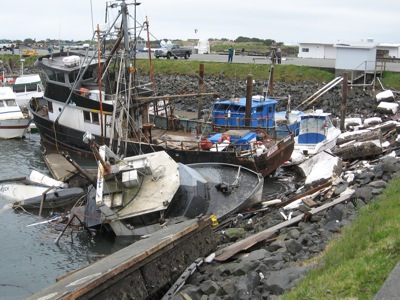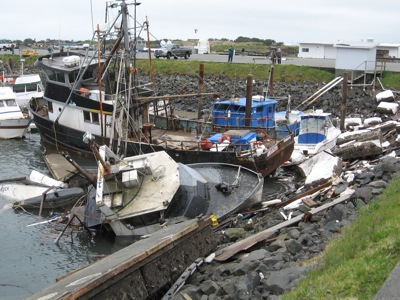Astoundingly, the mess left by Friday’s tsunami was confined to the harbor…for now. No, it wasn’t 1964, when a tsunami triggered by a quake off Alaska took out the harbor and half the town, killing 11 people. But hanging out there on the northwestern tip of California, Crescent City is “Tsunami Central” for this part of the continent.
Through a quirk of geography, the opening to the city’s horseshoe-shaped inner harbor seems to be lined up perfectly for seismically induced waves sweeping across the Pacific. The most impressive video clips I’ve seen were shot by Bryant Anderson. Both are posted on the website of the Crescent City Daily Triplicate. Anderson captured one clip while the tsunami sirens were still sounding:
Crescent City Tsunami from Bryant Anderson III on Vimeo.
Crescent City Tsunami from Bryant Anderson III on Vimeo.
Friday’s surge, which peaked with an 8-foot wave, had its way with what local officials say had been the most productive seafood landing harbor on the California coast. The next challenge is environmental, as salvage crews wait out the weekend’s extreme weather to tackle the potential threat of nearly 60 damaged and sunken boats, many full of diesel fuel, industrial lubricants and other contaminants. “Every one of the vessels has fuel on board,” said Alexia Retallack, who is helping coordinate recovery efforts for the state Department of Fish & Game’s Office of Spill Prevention & Response. “So every vessel that’s either sunken or currently in the harbor and compromised is a source of petroleum product,” she said.
They take the tsunami threat seriously around here. The area has a well-rehearsed evacuation plan. One resident told me a drill had been planned for mid-April. So when she was awakened by sirens early Friday morning, she first thought she had the date confused. Even the little area map in the hotel’s “guest services” book features a bold arc, clearly identifying the evacuation zone. Most hotels are inside of it, so they were evacuated with everyone else near the shoreline last week. Here are some photos of the scene I encountered when I arrived on Saturday:




There are more video clips of the Crescent City surge posted on YouTube. This one, while nothing like the horrifying pictures we’ve seen from Japan, shows the surge roiling at the mouth of the inner harbor “like inside a washing machine,” according to one official. Witnesses say the outgoing surge before the approaching wave drained the entire inner harbor, leaving fishing boats and docks sitting on a vast mud flat…until the water returned with unforgiving force.
Harbor Master Rich Young says he’s hoping to have at least a semblance of a home port restored for the fishing fleet by November, in time for the next crab season. You can hear my companion radio story, archived on the California Report website.
One thought on “Crescent City: “It’s a mess, all right.””
Comments are closed.


Do you suppose this is Ocean Karma — responding to the Japanese irreverence for the whales and dolphins? Did everyone see the movie, The Cove. How many wake-up calls do we need?